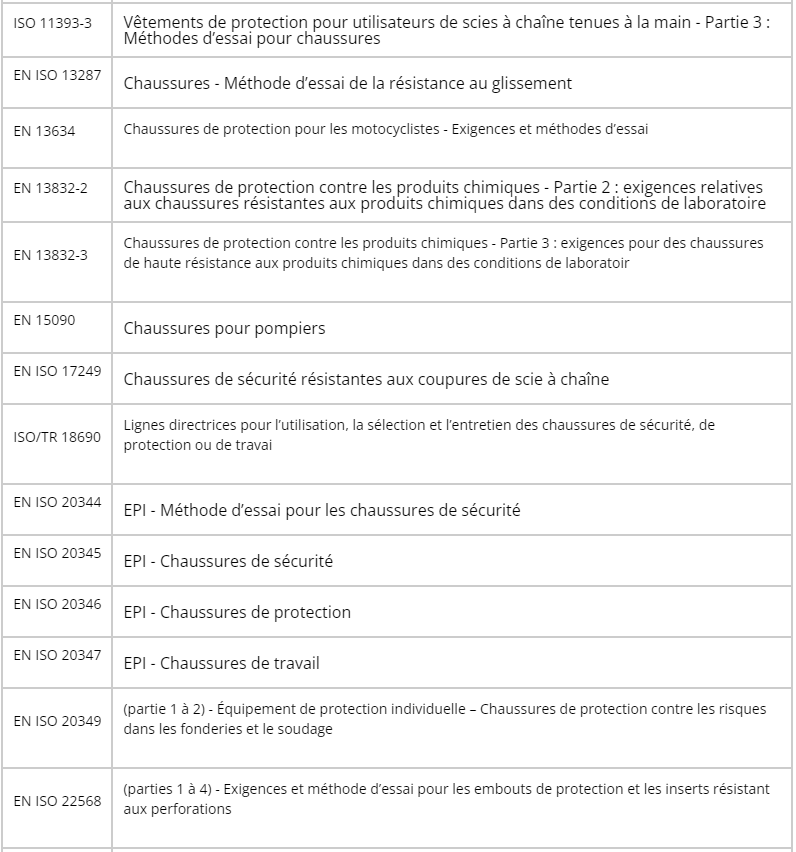The world of PPE
CERTIFICATION STAGES FOR SAFETY SHOES
Personal protective equipment (PPE), safety shoes in particular, are products subject to regulations governing their availability on the market. The products are tested and standardised to ensure they comply with European Regulation 2016/425/EU. Let's take a look at the steps in the procedure that manufacturers must follow to meet the requirements of the regulation.

STEP 1 - Categorise the level of risk
The manufacturer is responsible for defining the level of risk against which the safety shoe will protect its future user. This will determine the certification rules.
There are three categories of PPE, with corresponding obligations.
- Category 1: minor risks (e.g : Wellington boots for weather risks)
- Category 2: Other minor risks (e.g.: Shoes for mechanical risks)
- Category 3: Fatal or irreversible risks (e.g.: Shoes for chemical risks or electrical insulation)
Safety shoes meet the standard for category 2. To categorise and certify these shoes in category 2, the manufacturer must go through an approved organisation.
STEP 2 - Specify the standardisation categories corresponding to these risks and choose the appropriate standard for the PPE.
Rigorously define all risks so that the necessary standards can be specified during the certification process.

STEP 3: Choose an approved organisation to carry out the tests
Once the risk category and the standard corresponding to the product have been defined, the manufacturer’s choices must be validated through normative tests carried out by an approved organisation.
For personal protective equipment, French manufacturers mainly choose the CTC (Centre Technique du Cuir) as their approved organisation. An approved organisation is an organisation that has been designated by a European Member Country to assess the compliance of certain products before they are made available on the EU market, as well as in all countries (e.g. Tunisia or Morocco) that use standard EN ISO 20345 / 20347 with CE marking as their standard, with the applicable essential technical requirements.
The CTC carries out mechanical and chemical tests on materials and on the product as a whole.
Approved organisations in other European countries include Intertek in Italy, SGS in Finland and Inescop in Spain.

STEP 4: Certification validation request
Once all the tests have been carried out, the manufacturer will send a technical file to the approved organisation which includes:
> Risks covered and fields of use for the PPE
> A full description of the manufacturing process (materials, assembly sites, etc.)
> Test results confirming product compliance
> Final standard labelling of the footwear (SB, S1, S1P...)
> Instructions for using the PPE
After assessing the technical file, the approved organisation will issue an EU certificate.
STEP 5: Proving certificate validation
Finally, when the approved organisation has issued an EU certificate number, the manufacturer:
> Issues its statement of compliance. A statement of compliance is the document which certifies that the product complies with the essential requirements of the regulations applicable to it, and by which its liability is engaged. You can find the statements of compliance for all Parade products by going to the product information sheets and clicking on the "documentation" button.

> Applies the CE mark to the product in question.
> Can market its safety shoes in the European Union.
> Remains available to market supervisory authorities. The DGCCRF (General Directorate for Competition Policy, Consumer Affairs and Fraud Control) can carry out checks on production and products at any time. If the products inspected do not comply, the manufacturer will have to withdraw the entire range from the market.
What is the CTC (Centre Technique du Cuir)?
Since the CTC was founded in 1899, its main ambition has been to develop and consolidate its expertise in the design, manufacture and marketing of fashion, luxury and sports goods and personal protective equipment (PPE). In fact, it was one of the first approved organisations for PPE.
The CTC has issued over 35,000 EU certificates for safety shoes, protective gloves and protective clothing. These physical and technical tests, trials and certifications are guaranteed by ISO 17025 and ISO 17065 accreditations.
The CTC has a wide range of activities, including factory, social and environmental audits, consultancy, training and research and development.
DISCOVER OUR NEWSLETTER
By entering your email address, you will receive our newsletter with our latest products, services, news and advice on prevention and safety.
